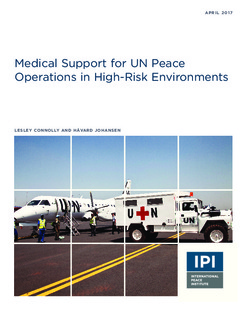| dc.description.abstract | The UN is increasingly deploying peacekeepers to conflict theaters where there is no political agreement and little or no peace to keep. Such high-risk environments make it harder for the UN to keep its personnel safe, fit, and healthy. While current UN missions have adopted a number of measures to mitigate these dangers, these developments do not address the systemic challenges facing medical support to UN peace operations. Therefore, this paper asks the question: What are the challenges to providing medical support to UN peace operations in high-risk environments? The purpose of medical support for peace operations is “to secure the health and well-being of members of United Nations [peacekeeping operations] in a timely and efficient manner.”1 At UN headquarters, this is managed by two central bodies: (1) the Medical Support Section (MSS), which oversees medical logistics for peace Operations; and (2) the Medical Services Division (MSD), which oversees medical support across the UN system. However, both units have come to focus on peace operations, resulting in replication of work and a lack of clarity in planning and coordination. With an increase in the number of integrated missions, similar issues have arisen in the field between the military and civilian components of medical support. As the landscape of peace operations continues to evolve, a number of initiatives have aimed to change UN medical support policies. Both the report of the High-Level Independent Panel on Peace Operations (HIPPO) and the secretarygeneral’s follow-up report highlighted the need for a coherent policy, leading to efforts to develop a medical performance framework for UN peace operations. Despite such initiatives, the UN needs to address five core challenges in order to meet its duty to care for its personnel in high-risk environments:
• Medical structures, planning, and coordination in UN headquarters: Both MSS and MSD suffer from lack of clarity in lines of authority and inadequate planning, and there is insufficient coordination between the two units.
• Standards of care: Although in theory the UN guarantees the same standards of care to all personnel, it has no way to enforce these standards. As a result, many countries contribute low-quality medical personnel and equipment, and countries that can afford to often bypass UN medical support systems, fostering resentment.
• Coordination in the field: Overly restrictive procedures, especially regarding casualty evacuation (CasEvac) and medical evacuation
(MedEvac) often prevent effective coordination of medical support.
• Training and capacity building: Although all UN personnel are supposed to receive predeployment medical training, including in basic first aid, levels of training vary from contingent to contingent.
• Resources and capabilities: UN missions are often forced to accept whatever equipment they can get, resulting in serious capability gaps, especially in terms of air assets. Based on these challenges, the UN and its member states could take a number of actions to enhance the efficiency and effectiveness of medical support to peace operations in high-risk environments:
• MSD and MSS should coordinate better and create links with the Office of Military Affairs (OMA).
• Medical support planning should be included in every aspect of mission planning and be tailored to the context.
• Missions should shift away from Level II hospitals, which are expensive and underutilized, instead exploring alternatives such as mobile medical units with surgical capabilities.
• Missions should focus on in-mission training, including by improving mentoring of medical personnel.
• MedEvac and CasEvac procedures should be simplified, decentralized, and made more flexible.
• The UN should seek pledges of medical equipment and personnel from member states in a more targeted way. | nb_NO |
